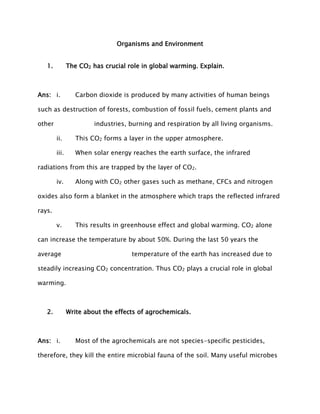
Organisms and Environment Exercise - MH-CET 2015
- 1. Organisms and Environment 1. The CO2 has crucial role in global warming. Explain. Ans: i. Carbon dioxide is produced by many activities of human beings such as destruction of forests, combustion of fossil fuels, cement plants and other industries, burning and respiration by all living organisms. ii. This CO2 forms a layer in the upper atmosphere. iii. When solar energy reaches the earth surface, the infrared radiations from this are trapped by the layer of CO2. iv. Along with CO2 other gases such as methane, CFCs and nitrogen oxides also form a blanket in the atmosphere which traps the reflected infrared rays. v. This results in greenhouse effect and global warming. CO2 alone can increase the temperature by about 50%. During the last 50 years the average temperature of the earth has increased due to steadily increasing CO2 concentration. Thus CO2 plays a crucial role in global warming. 2. Write about the effects of agrochemicals. Ans: i. Most of the agrochemicals are not species-specific pesticides, therefore, they kill the entire microbial fauna of the soil. Many useful microbes
- 2. such as nitrogen fixing bacteria, cyanobacteria which act as biofertilizers, are also eradicated. This affects the productivity of the soil. ii. Pest organisms develop resistance to some of the pesticides and thus they survive causing more damage. More amount of pesticides is then required to kill such resistant varieties. iii. Many pesticides such as organochlorines are persistent and nonbiodegradable. They pollute the environment and enter the food chain. iv. Organochlorines are lipophilic and hence remain accumulated in the fatty tissues of the animals. This creates serious problem of bioaccumulation. The amount of such pesticide goes on increasing as they travel through the food chain. The highest concentration occurs in the top level consumers which causes toxicity. v. Pesticides being toxic, handling them in industries or fields can cause various health hazards such as skin diseases, blindness, respiratory diseases, nervous disorders, etc. vi. Agrochemicals also contaminate the soil and ground water. Only 15% hits the target organisms, rest gets sprayed in nearby areas causing pollution. 3. Comment in details on the carbon cycle. Ans: i. Carbon is an important element as it forms 49% of the dry weight of all organisms. 71% of global carbon is present in the oceans. Therefore,
- 3. ocean is the major reservoir of carbon. Carbon is also present in all fossil fuels. ii. Respiration and photosynthesis are the events that keep the carbon in cyclic circulation. iii. During respiration, oxygen is used for combustion of carbohydrate as a result of which carbon dioxide and water are formed with the release of energy. iv. On the contrary photosynthesis utilizes carbon dioxide and water vapour liberating oxygen and producing carbohydrates at the same time. v. Solar energy is stored in the carbon – carbon bonds of carbohydrates during photosynthesis whereas respiration releases the same stored energy. vi. The main reservoirs for carbon dioxide are in the oceans and in rocks. Carbon dioxide is highly soluble in water and form mild carbonic acid upon dissolving. vii. This dissolved carbon dioxide precipitate as a solid rock or limestone which is calcium carbonate. viii. This reaction in the seas is aided by corals and algae which in turn builds the coral reefs made up of limestone. ix. Autotrophic green plants on land and in water take up carbon dioxide and manufacture carbohydrates by the process of photosynthesis.
- 4. x. The carbon stored in plants has three different fates, viz. liberation into atmosphere, consumption by animals upon feeding, storage in the plant till the plant dies. xi. Animals get their carbon requirement through their food. When autotrophs are consumed, the heterotrophs obtain carbon. Carbon in animals also has three fates, viz. release back into the atmosphere in the process of respiration, release of stored carbon from the body by the action of decomposers, or conversion into fossil fuels if buried intact. xii. Fossil fuel such as coal, oil, natural gas, etc. can be mined and burned for energy purposes. This burning releases carbon dioxide back into the atmosphere. xiii. Carbon from limestone can also be released if pushed to the surfaces and slowly weathered away. Subducting and volcanic eruptions can also release the stored carbon from sediments. xiv. Through burning of fossil fuels, there is great human interference with carbon cycle. Keep on visiting www.ednexa.com for more study material for MH-CET 2015 -Team Ednexa
